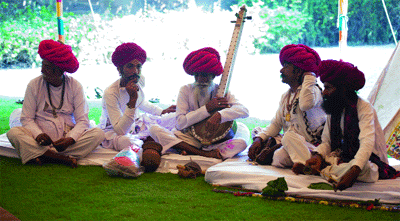For the first time, Jodhpur RIFF presented an afternoon with the Raika community, the primary camel herders of Rajasthan. By D Singh
This year RIFF put the spotlight on Rajasthan’s camel herder community with the demonstration of some of their rituals and tunes giving those present at the interactive session a slice of the ‘raika’ life.
The Raika legends say that they were ‘made’ by lord Shiva for looking after the camels which were first created by Shiva’s consort, Parvati. So the Raikas felt that it was their responsibility to keep camels healthy and happy so they never use camels for meat, or even sell female camels for their milk or hair.
Their knowledge about all aspects of the camel’s behaviour, breeding and health care is legendary. Rajasthan’s camel population has dropped from seven lakh to two lakh in 18 years. And the community which has been most affected is the Raika who are the traditional camel rearers.
The Raikas are a pastoral community in Rajasthan herding camels, goats and sheep. They live in groups on the outskirts of villages and combine crop production during the summer rains with pastoralism during the autumn-spring dry season. Raikas are mostly non-migratory and live with small herds of about 100 animals with a rich variety of breeds.
From the songs they sing on the long journeys they undertake to the way they communicate with the camels the session unfolded various facets of the community.
The communication is really important as one herder manages 50 camels and they control the herd based on the voice. Interestingly, a lot of musical instruments were invented out of the pastoral setting as people needed to communicate to the animals over a long distance. ‘Akal-dhakal’ is the art of communication between the camels and the breeders. They have different languages and sounds to assist the camels, from showing the camel way to water body for drinking or beckoning upon them from a distance,” said Iise Koehler Rollefson.
Traditionally, Raikas have been guardians of agro-biodiversity. They have developed a variety of indigenous breed for harsh climatic conditions and maintained them within restricted social groups.
The community probably moved eastwards to India with Muslim warriors in the 10th century. Rajput rulers, notably the Maharajas of Bikaner, Jodhpur, Udaipur and Alwar, employed some to manage their camels.
According to a study camel milk prevents Type 1 diabetes. It shows insulin-like activity when compared to cow milk. Speaking on the same, Bhanwar lal, a member of the raika community said, “Camel milk is not only beneficial for diabetes but many other ailments too.”
The ritual of camel healing by renditions of Bhopa-bhopi, the male and a female singer who are called upon to recite songs with undertones of spiritual elements in which they invoke ‘Bhapoji’, a historical figure and trailblazer regarded with saint like reverence by the raikas which is believed to heal the unwell or ailing camels. The Raikas worship ‘Bhapoji’. They also sing in his praise while the camels graze.
According to another belief ‘Bhapoji’ is the person who apparently brought camels from Pakistan. He lived in the fourteenth century who promised his niece with red and brown ‘she camels’ as a wedding gift.
They even have names designated to different camels, like, kali, bhuri, et al. which refer to the female camel. And the calves are mentioned by their mothers’ names.


























